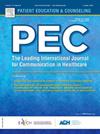Web-based educational tools and decision aids for patients with advanced cancer: A systematic review
IF 2.9
2区 医学
Q2 PUBLIC, ENVIRONMENTAL & OCCUPATIONAL HEALTH
引用次数: 0
Abstract
Objectives
To provide an overview of existing interactive web-based educational tools and decision aids for patients with advanced cancer and to evaluate their development process, content, feasibility, usability, and effectiveness.
Methods
Systematic literature search from inception to November 2023; screening with Covidence software; narrative analysis of results and quality assessment with the SUNDAE checklist.
Results
Sixteen web-based tools were identified: Seven for breast cancer, six for other specific cancers, and three for mixed populations. Studies predominantly used literature reviews, focus groups, and/or pre-existing tools for the development. The tools were heterogeneous and not all integrated aspects of end-of-life care. User tests included controlled trials, prospective interventional cohort studies, and a retrospective observational study, involving a total of 6192 patients. Results showed partially low adoption and infrequent use. Feasibility and usability were positively rated with high rates of user satisfaction. Preparation for and involvement in decision-making was partially supported by increased knowledge and improved doctor-patient relationships. Effects on involvement and self-efficacy in decision-making, participation, and distress were uncertain. Effects on quality of life, hope, anxiety, engagement in palliative care/advance directives, and survival were not found.
Conclusions
Despite high user satisfaction and adequate feasibility and usability, the evidence for other outcomes is diverse and low for long-term implementation. Tools are very heterogeneous in cancer entities and content. Although targeting patients with advanced cancer not all tools integrate aspects of palliative care and end-of-life.
Practice implications
In advanced cancer care, patient involvement in decision-making is complex. Web-based solutions are promising because of easy accessibility and dissemination and the ability to adapt information to patients’ needs and new treatment developments. Still, only a few evidence-based web-based educational tools and decision aids are available. Filling this gap is essential to empower patients to make informed and goal-concordant treatment decisions.
基于网络的教育工具和晚期癌症患者的决策辅助:一项系统综述
目的综述目前针对晚期癌症患者的交互式网络教育工具和决策辅助工具,并评价其开发过程、内容、可行性、可用性和有效性。方法系统检索成立至2023年11月的文献;使用冠状病毒软件进行筛查;使用SUNDAE检查表对结果进行叙述性分析和质量评估。结果确定了16种基于网络的工具:7种用于乳腺癌,6种用于其他特定癌症,3种用于混合人群。研究主要使用文献综述、焦点小组和/或已有的开发工具。这些工具是不同的,并不是所有的临终关怀都是综合的。用户试验包括对照试验、前瞻性干预性队列研究和回顾性观察性研究,共涉及6192例患者。结果显示部分采用率低,使用频率低。可行性和可用性被积极评价,用户满意度很高。知识的增加和医患关系的改善在一定程度上支持了对决策的准备和参与。参与和自我效能在决策、参与和痛苦方面的影响是不确定的。未发现对生活质量、希望、焦虑、参与姑息治疗/预先指示和生存的影响。结论:尽管用户满意度高,可行性和可用性充足,但其他结果的证据是多样化的,长期实施的证据也很低。工具在癌症实体和内容上是非常不同的。虽然针对的是晚期癌症患者,但并非所有的工具都能将姑息治疗和临终关怀结合起来。实践意义在晚期癌症治疗中,患者参与决策是复杂的。基于网络的解决方案很有前景,因为易于获取和传播,并且能够根据患者的需求和新的治疗发展调整信息。然而,只有少数基于证据的基于网络的教育工具和决策辅助工具可用。填补这一空白对于使患者能够做出知情和目标一致的治疗决定至关重要。
本文章由计算机程序翻译,如有差异,请以英文原文为准。
求助全文
约1分钟内获得全文
求助全文
来源期刊

Patient Education and Counseling
医学-公共卫生、环境卫生与职业卫生
CiteScore
5.60
自引率
11.40%
发文量
384
审稿时长
46 days
期刊介绍:
Patient Education and Counseling is an interdisciplinary, international journal for patient education and health promotion researchers, managers and clinicians. The journal seeks to explore and elucidate the educational, counseling and communication models in health care. Its aim is to provide a forum for fundamental as well as applied research, and to promote the study of organizational issues involved with the delivery of patient education, counseling, health promotion services and training models in improving communication between providers and patients.
 求助内容:
求助内容: 应助结果提醒方式:
应助结果提醒方式:


